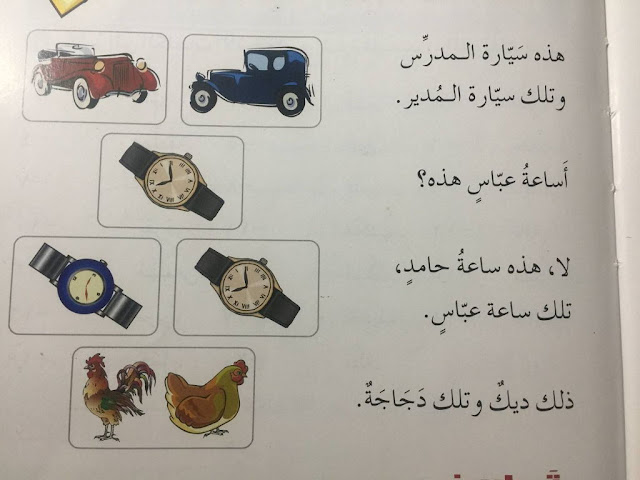Durusul Lughah Book 1 Ch. 7 | tilka | تلك
Let's continue studying chapter 7.
In this chapter, you will learn the demonstrative pronoun tilka (تِلْكَ).
Please read the text below
مَنْ هَذِهِ؟ = who is this.
هَذِهِ آمِنَةُ = this is Aminah.
hadhihi is demonstrative pronoun for pointing a singular feminine noun and near distance.
Because آمِنَةُ is singular feminine, so we have to use هَذِهِ
وَمَنْ تِلْكَ؟ = and who is that?
تِلْكَ فَاطِمَةُ = that is Fatimah.
tilka is demonstrative pronoun for pointing a singular feminine noun and far distance. In English, we say "that" for tilka.
هَذِهِ طَبِيْبَةٌ وَتِلْكَ مُمَرِّضَةٌ = this is a doctor and that is a nurse.
طَبِيْبَةٌ is singular feminine, the indication of the feminine is => it has ta marbutah "ة" ending.
مُمَرِّضَةٌ is also singular feminine with the same indication.
The singular masculine form of طَبِيْبَةٌ is => طَبِيْبٌ
The singular masculine form of مُمَرِّضَةٌ is => مُمَرِّضٌ
هَذِهِ مِنَ الهِنْدِ وَتِلْكَ مِنَ اليَبَانِ = this is from India and that is from Japan.
هَذِهِ طَوِيْلَةٌ وَتِلْكَ قَصِيْرَةٌ = this is tall and that is short.
The masculine form of طَوِيْلَةٌ is طَوِيْلٌ
The masculine form of قَصِيْرَةٌ is قَصِيْرٌ
مَنْ هَذَ؟ = who is this?
هَذَا حَامِدٌ = this is hamid.
هَذَا is demonstrative pronoun for pointing singular masculine noun and near distance.
وَمَنْ ذَلِكَ؟ = and who is that?
ذَلِكَ عَلِيٌّ = that is Ali.
ذَلِكَ (dhalika) is demonstrative pronoun for pointing singular masculine noun and far distance. In English, we say "that".
أَتِلْكَ دَجَاجَةٌ؟ = is that a hen?
لاَ, تِلْكَ بَطَّةٌ = no, that is a duck.
أ is hamzah istifham. It is used to ask yes/no question.
The answer can be yes "نَعَمْ" or no "لاَ"
مَا تِلْكَ؟ = what is that?
تِلْكَ بَيْضَةٌ = that is an egg
مَا is ma istifhamiyyah. It is used to ask a question. In English, we say it "what".
هَذهِ سَيَّارَةُ المَدَرِّسِ = this is the teacher's car.
وَتِلْكَ سَيَّارَةُ المُدِيْرِ = and that is the headmaster's car.
سَيَّارَةُ المَدَرِّسِ is mudaf-mudaf ilaih form.
سَيَّارَةُ المُدِيْرِ is also idafah (mudaf mudaf ilaih) form.
We've discussed idafah form. You should review back to get more understanding about idafah/mudaf mudaf ilaih.
Read here:
Mudaf and mudaf ilaih lesson from durusul lughah book 1
Idafah structure, rules, and examples
Examples of mudaf and mudaf ilaihi in al-Quran
أَسَاعَةُ عَبَّاسٍ هَذِهِ؟ = is this Abbas' watch?
لاَ, هَذِهِ سَاعَةُ حَامِدٍ, تِلْكَ سَاعَةُ عَبَّاسٍ = no, this is Hamid's watch, that is Abbas' watch.
ذَلِكَ دِيْكٌ وَتِلْكَ دَجَاجَةٌ = that is a rooster, and that is a hen.
From the text above, we learn the following things:
1. هَذَا = demonstrative pronoun to point a singular masculine noun for near distance. The meaning is this.
Example:
هَذَا أَحْمَدُ = this is Ahmad.
هَذَا قَلَمٌ = this is a pen.
هَذَا طَبِيْبٌ = this is a doctor.
2. هَذِهِ = demonstrative pronoun to point a singular feminine noun for near distance. The meaning is this.
Example:
هَذِهِ مَرْيَمُ = this is Maryam.
هَذِهِ سَاعَةٌ = this is a watch.
هَذِهِ طَبِيْبَةٌ = this is a doctor.
3. ذَلِكَ = demonstrative pronoun to point singular masculine noun for far distance. The meaning is that.
Example:
ذَلِكَ كِتَابٌ = that is a book.
4. تِلْكَ = demonstrative pronoun to point singular feminine noun for far distance. The meaning is that.
تِلْكَ طَالِبَةٌ = that is a student.
Summary in Picture
=====
Read the previous lesson here: chapter 6 | feminine noun in Arabic | هذه
Do you want to continue the lesson? do some exercises chapter 7, then we continue to study chapter 8.






No comments:
Post a Comment